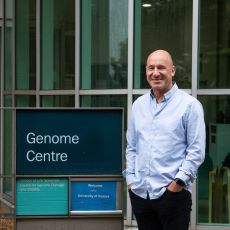Jon Baxter
DNA Topological Stress during Genome Duplication
We investigate the responses of cells to genome damage and their relationship to diseases, such as cancer, that can arise as a result.

The Genome Damage and Stability Centre is a University of Sussex Centre of Excellence. Our internationally-recognised centre provides a dynamic and collaborative environment for state-of-the-art research into genetic diseases. Our Centres of Excellence are drawing together world-leading experts and innovative approaches, creating a critical mass of knowledge, skills and training – and proving that a challenge is only impossible until it's done.

Professor Keith Caldecott FMedSci FRS
Our genomes are made up of long molecules of DNA that contain the genetic blueprint that tells every part of the body how to work. However, our DNA is attacked and damaged by harmful radiation and toxins present in our environment e.g. ultraviolet light from the sun and chemicals present in cigarettes and industrial pollutants. Importantly, our DNA is also under constant attack by endogenous genotoxins produced by our own cells e.g. as a result of the use of oxygen for cellular metabolism.
However, our cells contain sophisticated mechanisms for repairing DNA damage and protecting our genomes. These protective processes are the focus of our research, which we conduct using a range of cutting edge molecular, genetic, and cellular tools, including cells donated from people with genetic disorders in which DNA repair systems are faulty. Faulty DNA repair systems can result in very high incidences of cancer (more than 1,000 times higher than in the general population), and in neurodevelopmental or neurodegenerative disease.
By identifying the genes and processes that repair damaged DNA we are able to help clinicians diagnose and manage rare genetic disorders in which our genomes are unstable, and to gain insights into how cancer and neurological diseases arise and develop.
Our research groups focus on different aspects of DNA damage responses and genome instability. Our main research approaches include:
Keith Caldecott, Chris Chan, Helfrid Hochegger, Timothy Humphrey, Penny Jeggo, Alan Lehmann, Mark O'Driscoll, Ulrich Rass and Evi Soutoglou are molecular and cell biologists studying DNA repair processes, cell cycle control, and the replication of damaged DNA primarily in human and other vertebrate cells. They have identified new human DNA repair genes and have discovered deficiencies in DNA repair and DNA damage processing in several human genetic disorders, and are uncovering the molecular pathways that maintain the integrity and stability of the human genome.
Jon Baxter, Alessandro Bianchi , Tony Carr, Timothy Humphrey, Matt Neale and Ulrich Rass primarily use fission yeast (Schizosaccharomyces pombe ) and/or budding yeast (Saccharomyces cerevisiae) as model systems to understand how the genome is protected against the pathological impact of DNA damage during DNA replication and by processes such as DNA repair, cell cycle checkpoint control, and chromatin remodelling. These groups are also interested in fundamental aspects of genome biology such as DNA double-strand break formation during meiosis and the role of chromosome ends (telomeres) in the preservation of genome stability.
Aidan Doherty, Jasmeen Oberoi, Antony Oliver, Laurence Pearl and Luke Yates are biochemists and structural biologists studying the assembly, specificity, and regulation of multi-protein complexes involved in the recognition, repair and signalling of DNA damage. They are also involved in the discovery and development of novel small-molecule inhibitors with application as drugs for the treatment of cancer and other diseases.
Caldecott, Jeggo, Lehmann, O’Driscoll are investigating the relationship between the molecular defects and clinical features of human genetic disorders caused by faulty cellular responses to DNA damage. These groups have developed cellular tests for these disorders and work closely with clinicians and families across the world to uncover the molecular defects that cause these disorders, aiding clinicians in their diagnosis and clinical management.
DNA Topological Stress during Genome Duplication
Telomere Protection and Telomerase Regulation
DNA Strand Break Repair and Disease
Emeritus Professor
Chromosome Dynamics and Stability
Genome Replication and Repair
Cell Cycle Control
Chromosome Integrity Group
Emeritus Professor
Repair of UV Damage and Human Disorders
Genetic Recombination and Meiosis
Cancer signalling, Chromosomal translocations and Chaperones
Human Molecular Genetics and Cancer
Structural Biology of DNA Repair
DNA Repair, Signalling, Chaperones
DNA Repair Mechanisms and Chromosome Stability
Cell Biology of Genome Integrity
DNA Damage Checkpoints
We have strong links with the other subject groups in the School of Life Sciences and wider University including Neuroscience, Drug Discovery, Biochemistry and Biomedicine, and the Brighton and Sussex Medical School. We also work with scientists at other universities and research institutes nationally and across the world.
Our funding is awarded competitively from a number of prestigious national and international sources, including the UK government (Research Councils UK), Europe (European Research Council), and both national and international charities (e.g. Cancer Research UK, The Royal Society, and the Wellcome Trust).
If you have any queries, please contact us at GDSC@sussex.ac.uk.
Genome Damage and Stability Centre
Science Park Road
University of Sussex
Falmer, Brighton
East Sussex BN1 9RQ
UK
Tel.: +44 (0)1273 678123